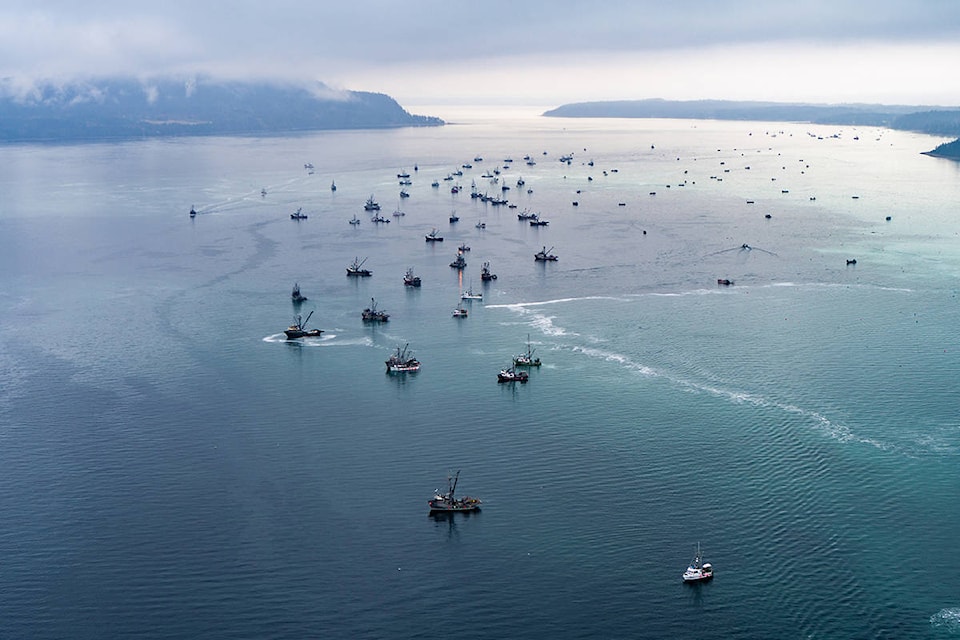With the Vancouver Island herring roe fishery around the corner, some are calling for major cuts to catch quotas for this year.
Fisheries and Oceans Canada (DFO) is taking comments on its Integrated Fisheries Management Plan through Jan. 20 for the 2020/2021 season.
Jim Shortreed, a volunteer from Victoria who works on herring spawning enhancement says now is not the time to be catching the herring but rather allowing the population to rebuild.
“Let’s just let it get bigger, let it grow, let it spread out until it encompasses the entire Strait of Georgia again,” he says.
He cites a project in False Creek where the population has been able to rebuild with help from hanging nets in the waters or covered pilings to provide surfaces on which the herring lay their eggs. There are other positive developments, he adds, such as in the Sechelt area or Howe Sound.
RELATED STORY: The two sides of the Strait of Georgia roe herring fishery
RELATED STORY: Opponents call for closure of herring fishery in Strait of Georgia
What is at stake in his view is the last large herring population in the Pacific region, especially the stretch between the Nanaimo area and Baynes Sound near the Comox Valley.
“This is the last large spawning grounds of herring in the Strait of Georgia,” he says.
Last year, there were major spawns in the Qualicum Bay area and at the north end of Denman Island, but other areas Shortreed says have faced an ‘extinction’ of herring populations. He points to researchers such as Scott Wallace of the David Suzuki Foundation calling DFO to reduce the quotas from the standard 20 per cent of the fishery down to no more than 10 per cent. In an article, Wallace cited a 2019 Fisheries and Oceans analysis of herring on Vancouver Island saying the reduction in harvest rate from 20 per cent to 10 per cent is the best means of mitigating any stock assessment errors.
Another question is whether DFO might take part of the quota devoted for the herring roe fishery and move it to the fish and bait herring fishery period, which starts in the fall.
Shortreed says they did have some influence over the food and bait herring fishery last fall, as DFO removed one area in the Gulf Islands down to Active Pass from fishing.
He is not alone in opposing the commercial harvest. The group Conservancy Hornby Island is circulating a petition through Change.org calling for people to “say no” to the herring roe fishery. To back its case, the group points to severe declines and shutdowns of four commercial herring fisheries.
“The Strait of Georgia is home to the last large population, but it is being pushed to the brink. We simply cannot risk the complete collapse of this foundational species,” the group’s online petition says.
The commercial seafood industry takes a different view. One factor they point to is the regular fluctuation in the size of the herring fishery.
“These populations do go up and down,” says the Herring Conservation and Research Society’s Rob Morley. “The stocks have increased by about one-third over the last 10 years.”
He adds the herring spawn in 2020 was one of the largest in decades, even though DFO had forecast a decline. As well, he points out the quota only comes into play when the spawning biomass is large enough to permit the fishery.
Last year, he says, was a strong year with herring showing up in more areas and a large number of juveniles recruited into the spawning population, so he expects DFO will probably not reduce the quota after the comment period.
While he realizes the industry is not the size it once was, herring still generates about $40-50 million a year in export income for B.C., including revenue for related businesses. It also provides work during times of the year when other fisheries might be slow. On top of this, it has a one of the highest Indigenous participation rates of any fishery in B.C., he says, with 23 per cent of seine and 37 per cent of gill net licences owned by Indigenous individuals or communities.
“It’s still a very significant fishery,” Morley adds.
There is more information about DFO’s comment period at bit.ly/3if28l3
mike.chouinard@comoxvalleyrecord.com
Like us on Facebook and follow us on Twitter.
